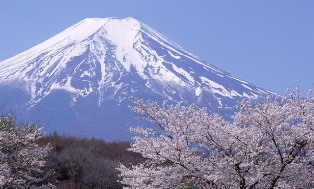| |
JAPAN STUDY TOUR REPORT 2009 |
|
| |
Any trip to Japan is a dream by itself. This specific trip though, was a carefully planned, first class ticket to view the most important elements of the Japanese culture, history, political system, as well as the mentality of the society and a glimpse of the modern Japanese lifestyle.
I feel privileged to have participated in the 2009 Study Tour of Japan and therefore I would like to express my gratitude to the Japanese Embassy in Athens for their selection, and the Ministry of Foreign Affairs for the excellent organization of every detail of the trip. I would also like to thank our hardworking guides Ms.Akiko and Ms.Yoko as well as the people from the MoFA Mr.Santaro and Ms.Natsuko for their invaluable help.
Tokyo
The long awaited trip finally started on Sunday October 18 th and we arrived in Tokyo on Monday afternoon. After a meeting ceremony, where I had the chance to meet the other participants, Mr.Georgios Zafeiris a Greek diplomat in Tokyo, as well as Japanese diplomats who spoke Greek (!), we were left free to do whatever we pleased on our first night in the city. Some of us went to a pub where Japanese people had their beer while fanatically watching baseball. Afterwards we walked until the ocean, to see more of the city and get a feel of its scale.
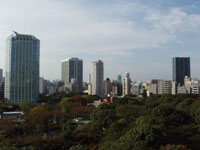 All of us where amazed by the absence of loud noise in the city. The speed limit is very low; cars have no loud exhaust pipes, and many people use bicycles. It seemed that the asphalt was also specially engineered to absorb noise from the tire friction. All this, combined with the numerous parks around the area of the hotel, contributed to a very positive opinion about the standard of living in Tokyo.
|
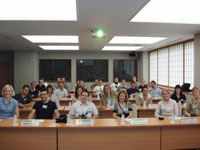 Tuesday started with a visit to the Ministry of Foreign Affairs, to attend a lecture on relations between Japan and Europe. I was glad to hear Mr. Hiroshi KAWAMURA express the willingness of his country to create more powerful bonds with Europe.
|
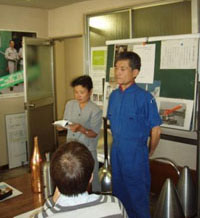 Afterwards we paid a visit to the Kitajima-Shibori Factory, a medium sized metal workshop. I was impressed by the craftsmanship of the final products, the organization of the factory, and the fact that even the manager of the factory participated in manual labor.
Despite his busy schedule, he answered all of our questions.
|
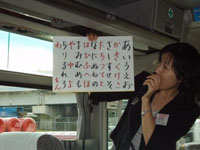 In the meantime, our lovely guide Akiko-san taught us a little Japanese whenever we had free time in the bus, such as basic greeting phrases, counting up to ten and thus up to 99, the alphabet, and a few basic Kanji (logographic characters).
|
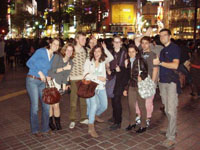 On our free time in the afternoon, we decided to visit Shibuya, one of the busiest crossings in Tokyo. After navigating in the labyrinth of the Tokyo subway we finally made it! This place seemed to me like a whole different world. The lights the sounds and the huge screens on the buildings, were truly an overload of information. Despite my surprise I was tremendously happy to be there because that was the image of Tokyo that I had in my mind prior to my visit. After staying in the center of the square for a few minutes to actually realize we were there, we started walking around and finally decided to have dinner in a traditional restaurant in a basement. After eating we continued our walks for as long as the schedule of the subway permitted us. |
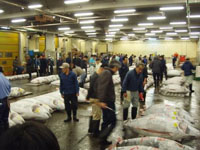
Wednesday started with a morning visit to the Tokyo fish market. The fact that we were still a little jet lagged helped us wake up at 5:00 am to be in time for the tuna-fish auctions. It was an interesting sight, and we tried not to interfere with the work of the fishermen. At dawn, the market seemed to be at the peak of its livelihood.
Afterwards, at the Ministry of Foreign Affairs, we attended a dynamic lecture by Prof. Seichi FUJITA on the applying of KAIZEN (constant improvement) on Japanese Industry. It was fascinating to hear how Japanese people try not only to increase their productivity, but to improve every aspect of their products by small steps at a time, in their effort to find simple and innovative solutions to their problems.
|
At noon, we visited Keio University, the oldest and one of the most prestigious institutes of higher learning in Japan. We were given a tour at the most significant places of the Campus, among them the Noguchi Room, an architectural masterpiece of the 50's. Afterwards we had lunch at the student restaurant where we had the chance to meet students and discuss about the differences of our educational systems. Then we attended a lecture by Prof. Toshiro TANAKA about the way Europe is perceived in Japan and Asia.
|
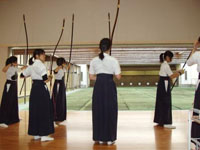 Our visit ended with a marvelous demonstration of an Archery Competition from a group of students, where we had the rules and the basics of Archery explained to us.
Our little free time was spent at Shinjuku were we visited department stores and tried the local cuisine.
Coming back to the hotel, we could not feel fatigue because of all the great things that we saw and all the fun we had during the day.
|
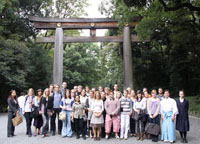 Thursday started with a lecture by Mr. Tsuneo WATANABE on the current political situation of Japan, and the challenges that the new government has to overcome.
Our next destination was Meiji Jingu, a Shinto Shrine in the center of Tokyo dedicated to the soul of Emperor Meiji and his consort, Empress Shoken. We attended a brief lecture on the principles of Shinto and then headed to the Main Shrine to express our respect. Finally we attended a Shinto prayer and had the chance to see a part of a Shinto wedding. The natural beauty of the forest along with the traditional design of both the old and the new buildings was an overwhelming experience. |
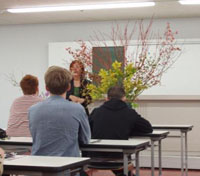 In the afternoon we visited Sogetsu-Kaikan for a demonstration of Ikebana flower arrangement. I had never seen such a modern perspective on creating a composition with flowers, and yet the art of Ikebana has a history of more than 5 centuries!
We were then given the opportunity to improvise our own Ikebana arrangements according to our brief lesson.
|
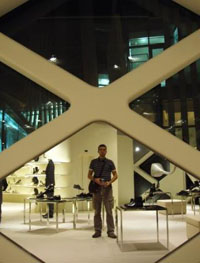 I dedicated this afternoon to view as much Tokyo Architecture as I could along with another participant who is also an Architect. We visited Omotesando Street and saw the magnificent commercial buildings by Herzog de Meuron, MVRDV, Toyo Ito, Sanaa Architects. Then we walked to Roppongi to see the Tv-Asahi building and the National Art Center.
We were also lucky enough to find a building by Tadao Ando and admire the minimalism and the quality of his design.
By walking throughout Tokyo for more than 5 hours, I had the chance to go into small neighborhoods and have a look at the ordinary smaller houses as well. I was amazed at how well the Japanese houses are built and how thorough their details are being designed regardless of their size or budget. Even at the most narrow streets I couldn't stop being surprised and gaze at buildings (small offices, restaurants, etc) which were of significant architectural quality.
|
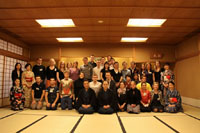 On Friday we attended a lecture by Prof. Hikari ISHIDO on Japanese Economy. It was interesting to see how Japan accomplished to become a great economic power, and its future economic strategies.
We then visited the National Diet of Japan. We were informed on the function of the building, in accordance to the function of the Japanese Democracy. We had the chance to see the Chamber of the House of Representatives where I noticed a few similarities with the Greek Parliament.
|
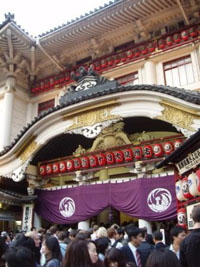 After having lunch at the “Ganko Ginza-Icchome” we went to Urasenke to experience a Tea Ceremony. The house was traditional, covered with Tatami mattresses and divided by Soji panels. In the back, a beautiful traditional garden completed the already overwhelming scenery. We witnessed an original enactment of the traditional Tea Ceremony, and then had the opportunity to participate in a Tea Ceremony prepared especially for us.
Our last formal visit for the day was at the performance of the Kabuki-za Theater. The whole experience was more than worthwhile, and the 4 hours of duration which seemed a little too much before we arrived, passed without the slightest discomfort. The English translation helped us understand the play, and the talent of the performing actors, the singers and the musicians was beyond all expectation.
We then went to a restaurant to celebrate our successful stay in Tokyo, and celebrate the birthday of two participants of the Study Tour.
|
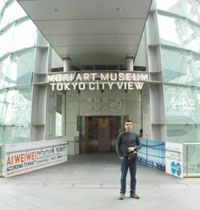 Saturday started with some free time on our hands. Some of us visited the Mori Art Museum, where we saw the exhibition of AI WEIWEI - a Chinese Artist, Sculptor and Architect. We also admired the view of Tokyo, since the Museum is located at the 52 nd floor of a skyscraper.
After a quick visit to Akihabara, we joined the rest of the group to pay a visit to the Panasonic Center in Odaiba.
As I am very interested in advanced technology, I found the tour very exciting.
|
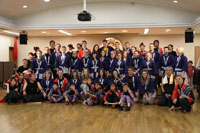 Our last scheduled visit in Tokyo, was to attend a Traditional Japanese Drum Concert by the group Nagisa Taiko. The concert was performed especially for us, in a very dynamic and impressive tempo. Then, to my surprise, all of us were given a lesson on how to play the drums in a synchronized way! The following buffet party was the most delicious home made food we had in Tokyo. I then noticed that the Nagisa Taiko, apart from professional drum players, and amazing chefs, are also professional Karaoke singers! We sang English songs and tried to sing Japanese songs as well, and the party was a huge success. |
Hiroshima
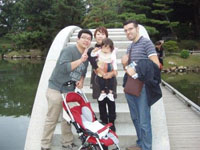 With all these wonderful experiences from Tokyo, we departed for Hiroshima on Sunday morning.
On our arrival we heard a first briefing about the recent history of the city by our guide Ms Akiko.
Hiroshima is now a very modern city with more than a million inhabitants, and the rivers that pass through the city give an exceptional beauty.
We then met our host families. I was hosted by a very friendly young family with one little daughter. They had prepared various lists of sightseeings for me to choose from, so I chose to see the Hiroshima Castle and the Shukeien gardens. We then had a very tasty dinner at their house where I met my host mother's brother, his wife and his little son.
Afterwards I had the opportunity to visit the public baths in Hiroshima, and the experience was very interesting and relaxing.
|
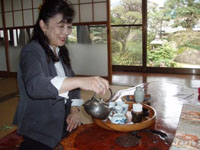 After a good nights sleep my host mother had prepared traditional Japanese breakfast for me. It was very tasty. Then we visited a traditional house of a friend with a beautiful garden, were I was honored to attend a tea ceremony! We then had the specialty of Hiroshima for lunch, okonomiyaki pork.
|
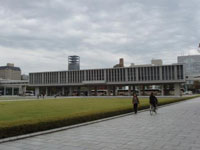 After the home stay program, I joined the rest of the group at the A-bomb museum. The museum told the story of the tragedy with objectivity, by showing all the facts of the war prior and after the dropping of the atomic bomb. The instant death of so many innocent people as well as the inestimable damage to the lives of those who survived is something shocking. The narration of the survival story by Mr. Kenji KITAGAWA was also shocking. He went through that awful experience as a young boy, yet during his speech he was calm and conciliatory. His appeal for the abolishment of nuclear weapons is something that every civilized person should support. |
On Tuesday morning we had the pleasure of taking the “Shinkansen” super express train to Kyoto. The ride was pleasant and vibration free, something very hard to believe considering the fact that we travelled at 300 Km/h !
Kyoto
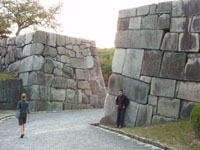 The entire group was enthusiastic about Kyoto, since 17 Historic Monuments that have been declared by UNESCO as World Heritage Sites are located there. Our tour started at the Nijo Castle. The beauty of the gardens and the buildings was unique. The safety measures used by the Shogun to protect him from his enemies where also very interesting.
|
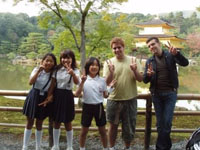 We then headed to Kinkaku-Ji also known as the Golden Pavilion. The image of the Temple behind the lake was truly a majestic view. |
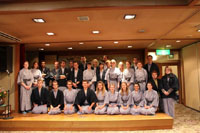
Our accommodation for the night was into a traditional Japanese hotel, the Sansui-Kan at Osaka. The natural beauty of the place around the hotel was excellent, and the stay included all the elements of Japanese culture. We wore our Yukatas and slept on Japanese Futon mattresses laid directly on the Tatami. The dinner and the breakfast were also traditional. We also visited the public baths to cleanse ourselves and relax before going to sleep.
|
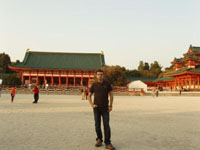 Our final day in Kyoto included numerous important Temples such as the Nanzen-ji , the Kijomizu-dera ,the Kodai-ji as well as the Heian-Jingu Shrine. A viewing of so many places in one day by a group of our size would not be possible without the excellent planning of our two lovely guides Yoko and Akiko.
|
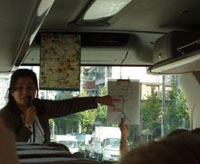 I could have stayed at each one of those places for all day long, but our tight schedule meant that we had to absorb as much information as possible during our short visits. In any case, apart from a close look at the religious beliefs and the Japanese customs, these visits were a lesson for me, regarding the integration of a building to its natural environment and the use of plants, water and other natural materials to create a sense of harmony in the public space.
|
Epilogue
Coming back from this trip, I can now look back and realize that it was a lifetime experience. I hope I can manage to repeat my visit in the future, and see more of Tokyo, and the rest of Japan. I am considering applying on educational programs (e.g. Vulcanus) and scholarships that help European Students travel to Japan, learn the language and study briefly at the local Universities. I am more interested in modern and traditional Japanese Architecture after my trip and Japanese culture in general, so I am willing to find out more information on them.
My thought on the Japanese European relations, is that we should try to strengthen our bonds, in various ways. Student exchange programs are vital for the knowledge of each others culture and the promotion of cooperation in science. I would also like to see more exchange in cultural matters such as film festivals, art exhibitions etc. Political cooperation is also necessary for helping economic stability, maintain peace, and promoting fair trade.
I would like to thank once more, the embassy of Japan in Athens and the MoFA for giving me this magnificent and educative experience as well as the opportunity to meet so many interesting people from all around the world.
|
|
|
|
